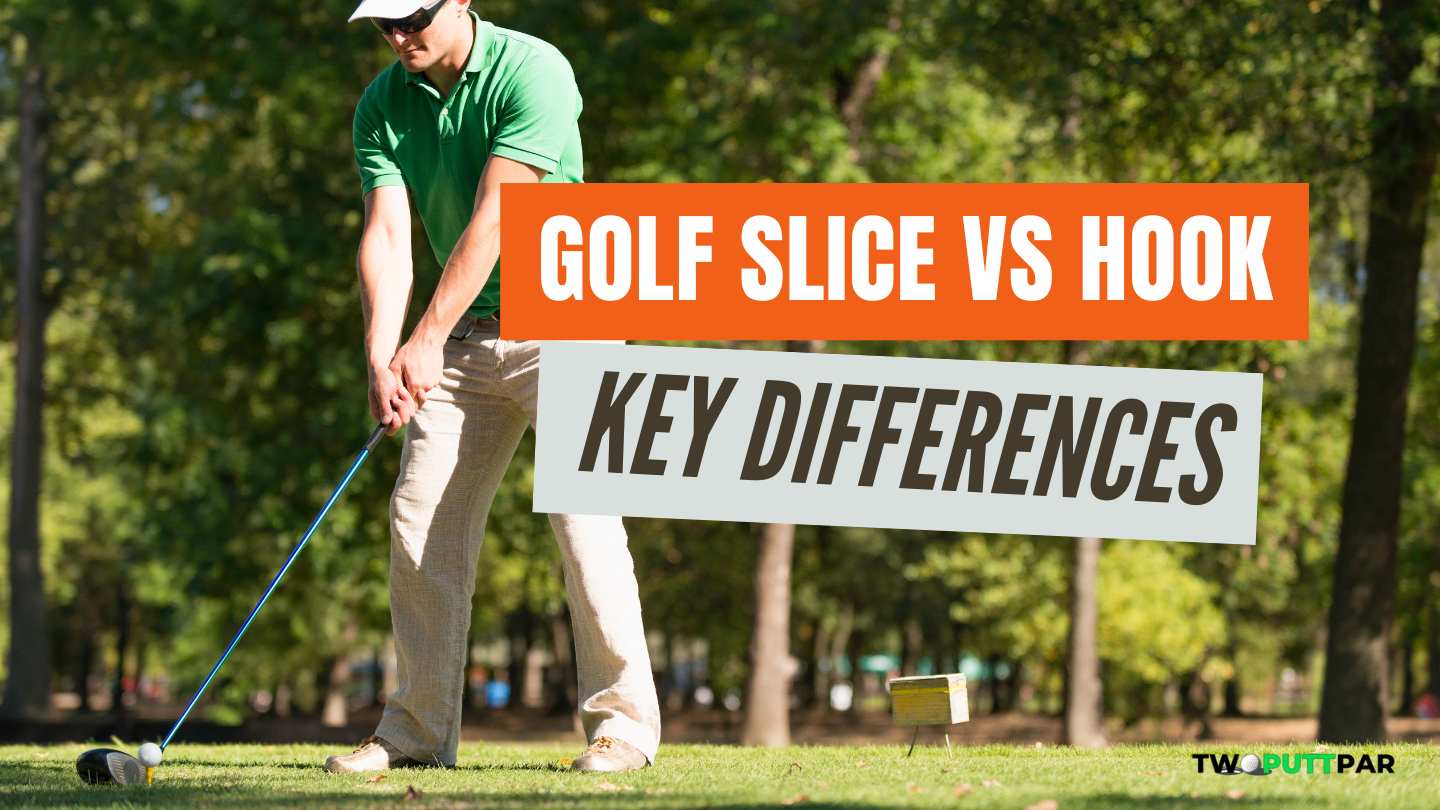
Mid-Handicap golfer who loves to share his rounds and experiences playing courses all around the UK in a hope that it will help others find those hidden gem golf courses.
I seek out golf courses that don’t get the credit they deserve and are often overlooked for the bigger more well known ones.
In the intricate game of golf, understanding the subtleties of different shots can dramatically impact your performance.
Understanding the differences between slice and hook is crucial for consistent and accurate shots on the course.
So let’s get started!
Golf Slice and Hook are two distinct shots; a slice curves the ball dramatically from left to right, while a hook sends the ball on a strong curve from right to left, with the exact direction dependent on the golfer’s orientation.
What Is a Hook In Golf?
A hook in golf is a shot that results in the ball curving significantly from right to left (for a right-handed player) or left to right (for a left-handed player).
The hook shot in golf can be both a blessing and a curse for golfers. For beginners, it can often result from an incorrect grip or swing path, leading to unintentional hooks that can send the ball veering off the intended course.
However, for more advanced players, mastering the hook shot can be a strategic advantage. It allows them to navigate around obstacles on the course and reach the green in fewer strokes.
The key to executing a successful hook lies in the golfer’s ability to manipulate their club face orientation and swing path.
By closing the clubface relative to the swing path at the point of impact, the golfer can induce the right-to-left spin that defines a hook shot.

What Is a Slice In Golf?
A slice in golf is a shot in which the ball curves dramatically from left to right (for a right-handed player) or right to left (for a left-handed player).
In the world of golf, a slice is one of the most common issues plaguing both beginners and experienced players alike.
This type of shot typically occurs due to an open clubface at the point of impact, coupled with an outside-in swing path.
The result is a ball that starts left of the target line and curves significantly to the right, often leading to frustrating outcomes.
For many, the slice is a troublesome error to rectify, as it requires fundamental changes to grip, stance, and swing mechanics.
However, understanding the cause and effect of a slice is the first step towards improvement.
For more advanced players, being able to intentionally slice the ball can be a useful tool when needing to navigate around obstacles on the course.
Golf Slice vs Hook – Key Differences
| Golf Slice | Golf Hook | |
|---|---|---|
| Definition | A shot where the ball curves significantly from left to right (for a right-handed player) or right to left (for a left-handed player). | A shot where the ball curves sharply from right to left (for a right-handed player) or left to right (for a left-handed player). |
| Common Causes | Typically caused by an open clubface at impact and an outside-in swing path. | Often results from a closed clubface at impact and an inside-out swing path. |
| Impact on Game | Can lead to frustrating outcomes if unintentional, but can be used strategically to navigate around obstacles. | Can be problematic for beginners who unintentionally hook the ball, but can be used advantageously by advanced players to steer around obstructions. |
| Correction Techniques | Requires changes to grip, stance, and swing mechanics. | Requires manipulation of club face orientation and swing path. |
The key differences between a golf slice and hook are that a slice curves the ball dramatically from left to right, while a hook sends the ball on a strong curve from right to left, with the direction being dependent on the golfer’s orientation.
Golf Slice
A slice in golf is a shot where the ball curves significantly from left to right for a right-handed player or vice versa for a left-handed player.
This typically occurs due to an open clubface at the point of impact, coupled with an outside-in swing path.
The result is a ball that starts left of the target line and curves considerably to the right. It’s often a common issue for many golfers, especially beginners, and requires changes to grip, stance, and swing mechanics to rectify.
However, advanced players can intentionally use a slice to navigate around obstacles on the course.
Golf Hook
On the other hand, a hook in golf is a shot resulting in the ball curving sharply from right to left for a right-handed player, or from left to right for a left-handed player.
This can occur when the golfer’s clubface is closed relative to the swing path at the point of impact, inducing a right-to-left spin on the ball.
While this can be a problem for beginners who unintentionally hook the ball, more advanced players can use a hook to their advantage. It allows them to steer the ball around obstructions and reach the green in fewer strokes.
How to Correct a Hook
Correcting a hook in golf involves adjustments to your grip, stance, and swing path to ensure the clubface is square at impact and your swing path is straight.
Adjust Your Grip
The first step to correct a hook is to adjust your grip. A strong grip, where the hands are turned too far to the right on the club (for a right-handed player), can often lead to a closed clubface and thus a hook.
To rectify this, position your hands so you can only see two knuckles of your left hand (for right-handed players) when you look down at your grip. This is considered a neutral grip and helps to keep the clubface square at impact.
Check Your Stance
Next, ensure your stance is not promoting a hook. If your feet, hips, or shoulders are aligned too far to the right (for a right-handed player), this can encourage an inside-out swing path, leading to a hook.
Aim to align your body parallel to the target line, with your feet shoulder-width apart for the best balance and posture.
Improve Your Swing Path
The final key area to focus on is your swing path. An inside-out swing path is a common cause of a hook. To correct this, try to swing the club straight back and through.
Visualise swinging along the line of your feet, which should be parallel to the target line. Practising this straighter swing path can help eliminate the right-to-left curve of a hook.
How to Correct a Slice
Rectifying a slice in golf involves enhancing your grip strength, adjusting the club face, and perfecting your swing dynamics.
Strengthen Your Grip
The initial strategy to correct a slice is to strengthen your grip. A weak grip can contribute to an open clubface at impact, resulting in a slice.
To address this, adjust your left hand on the grip so that you can see more knuckles when you look down. This stronger grip will assist in keeping the clubface square at impact, reducing the chance of a slice.
Adjust the Club Face
The second strategy involves making adjustments to the club face. An open club face often leads to a slice.
Begin with the clubhead behind the ball and then lift it over your head until your hands are in front of your face. This movement can help to ensure the club face is not open at impact, thus correcting the slice.
Perfect Your Swing Dynamics
The final strategy to fix a slice is to focus on your swing dynamics. The angle and path of your swing play a pivotal role in whether you hit a slice or a straight shot.
At the top of your backswing, your club should be at a 45-degree angle, with the clubhead pointing towards the target. Additionally, ensure that your left shoulder (for right-handed players) is under your chin during your backswing.
This will promote a more balanced and controlled swing, helping to eliminate a slice.
FAQs
Q: How is the club face position different in a slice and a hook?
A: In a slice, the club face is open at impact, causing the ball to curve to the right. In a hook, the club face is closed at impact, resulting in a leftward curve of the ball.
Q: What causes a slice or a hook?
A: A slice is typically caused by an open club face at impact, an out-to-in swing path, or a combination of both. A hook is often the result of a closed club face, an in-to-out swing path, or a combination of both.
Q: Which shot tends to go straighter, a slice or a hook?
A: Generally, a hook has a higher chance of going straighter compared to a slice. The hook shot typically starts left of the target and curves back to the right, whereas a slice starts right and continues curving further right.
Q: How can I fix my slice off the tee?
A: To fix a slice off the tee, you can try adjusting your grip, improving your swing path from out-to-in to in-to-out, or working on your club face position at impact.
Q: How can I fix my hook shot?
A: To fix a hook shot, you may need to adjust your grip, focus on swinging from in-to-out, or work on aligning your club face to a more neutral position at impact.
Q: What is the difference between a draw and a hook?
A: A draw is a controlled shot that starts to the right of the target (for right-handed golfers) and curves slightly back to the left. A hook, on the other hand, is a shot that starts left of the target and curves sharply to the left.
Q: Why do some golfers tend to hook the ball more often?
A: Golfers tend to hook the ball more when their swing path is too much from in-to-out, their club face is closed at impact, or a combination of both factors.
Q: What happens if I have an open club face during impact?
A: If you have an open club face at impact, it is likely to result in a slice with the ball curving to the right (for right-handed golfers).
Q: What causes a golf ball to curve left (for right-handed golfers)?
A: A golf ball curves to the left for right-handed golfers when the swing path is from out-to-in and the club face is closed at impact.
Conclusion
In conclusion, a golf slice and hook are two common mishits that can plague any golfer. Both shots can result in lost distance and accuracy, making it crucial for players to understand the key differences between them.
By identifying the root cause of each shot and implementing proper adjustments through practice and coaching, golfers can improve their consistency on the course.
Affiliate Disclaimer – As an affiliate, we may earn a commission from qualifying purchases. We get commissions for purchases made through links on this website from Amazon and other third parties.





Leave a Reply